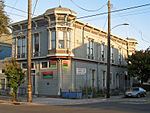Oakland Point, Oakland, California
Alameda County, California geography stubsGeography of Oakland, CaliforniaHeadlands of CaliforniaLandforms of Alameda County, CaliforniaNeighborhoods in Oakland, California

Oakland Point, or Gibbons' Point, was a small promontory formerly on the eastern shore of San Francisco Bay in West Oakland, California. It was located in the vicinity of what is now the Port of Oakland shipping terminal.
Excerpt from the Wikipedia article Oakland Point, Oakland, California (License: CC BY-SA 3.0, Authors, Images).Oakland Point, Oakland, California
7th Street, Oakland
Geographical coordinates (GPS) Address Nearby Places Show on map
Geographical coordinates (GPS)
| Latitude | Longitude |
|---|---|
| N 37.80775 ° | E -122.30443888889 ° |
Address
7th Street
7th Street
94607 Oakland
California, United States
Open on Google Maps






